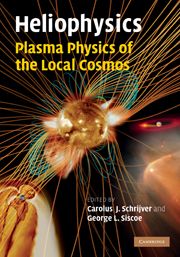Book contents
- Frontmatter
- Contents
- Preface
- 1 Prologue
- 2 Introduction to heliophysics
- 3 Creation and destruction of magnetic field
- 4 Magnetic field topology
- 5 Magnetic reconnection
- 6 Structures of the magnetic field
- 7 Turbulence in space plasmas
- 8 The solar atmosphere
- 9 Stellar winds and magnetic fields
- 10 Fundamentals of planetary magnetospheres
- 11 Solar-wind– magnetosphere coupling: an MHD perspective
- 12 On the ionosphere and chromosphere
- 13 Comparative planetary environments
- Appendix I Authors and editors
- List of illustrations
- List of tables
- References
- Index
1 - Prologue
Published online by Cambridge University Press: 05 August 2013
- Frontmatter
- Contents
- Preface
- 1 Prologue
- 2 Introduction to heliophysics
- 3 Creation and destruction of magnetic field
- 4 Magnetic field topology
- 5 Magnetic reconnection
- 6 Structures of the magnetic field
- 7 Turbulence in space plasmas
- 8 The solar atmosphere
- 9 Stellar winds and magnetic fields
- 10 Fundamentals of planetary magnetospheres
- 11 Solar-wind– magnetosphere coupling: an MHD perspective
- 12 On the ionosphere and chromosphere
- 13 Comparative planetary environments
- Appendix I Authors and editors
- List of illustrations
- List of tables
- References
- Index
Summary
A voyage through the local cosmos
The place that we call home, the surface of the planet Earth, presents us with an environment in which temperatures range over perhaps 80 kelvins from the cool arctic regions or mountain tops to the hottest deserts or jungles. We are composed largely of liquid water with a density of 1 gram per cubic centimeter; we walk on solid rock with a density that is about five times higher than this and breathe a gas with a density that is 1000 times lower. These conditions are such that chemical reactions and phase transitions between solids, liquids, and gases are the processes that dominate our everyday experience.
When we move away from the Earth's surface, conditions change markedly. Deep in the Earth, for example, where densities are still only a few times higher than those at the surface, the pressure rapidly increases and temperatures reach up to some 20 times those characteristic of the range that is comfortable to mammals. In the Sun's core densities are larger still, almost a hundred times that of liquid water, at temperatures that exceed ten million kelvins. Those same temperatures may be found again in the hottest, flaring parts of the Sun's outermost atmosphere, called the corona, and furthermore are often characteristic of the ion energies high above the Earth around the altitudes where geosynchronous satellites orbit.
- Type
- Chapter
- Information
- Heliophysics: Plasma Physics of the Local Cosmos , pp. 1 - 20Publisher: Cambridge University PressPrint publication year: 2009



